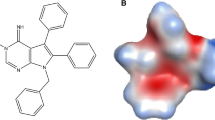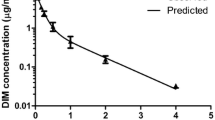Abstract
Purpose
SR13668 (2,10-dicarbethoxy-6-methoxy-5,7-dihydro-indolo-(2,3-b)carbazole), is a new candidate cancer chemopreventive agent under development. It was designed using computational modeling based on a naturally occurring indole-3-carbinol and its in vivo condensation products. It showed promising anti-cancer activity and its preclinical toxicology profile (genotoxicity battery and subchronic rat and dog studies) was unremarkable. However, it exhibited a very poor oral bioavailability (<1%) in both rats and dogs. Therefore, a study was initiated to develop and evaluate in dogs and non-human primates formulations with a more favorable oral bioavailability.
Methods
Two formulations utilizing surfactant/emulsifiers, PEG400:Labrasol® and Solutol®, were tested in dogs and monkeys. Levels of SR13668 were measured in plasma and blood using a high-performance liquid chromatograph–tandem mass spectrometer system. Non-compartmental analysis was used to derive pharmacokinetic parameters including the bioavailability.
Results
The Solutol® formulation yielded better bioavailability reaching a maximum of about 14.6 and 7.3% in dogs and monkeys, respectively, following nominal oral dose of ca. 90 mg SR13668/m2. Blood levels of SR13668 were consistently about threefold higher than those in plasma in both species. SR13668 did not cause untoward hematology, clinical chemistry, or coagulation effects in dogs or monkeys with the exception of a modest, reversible increase in liver function enzymes in monkeys.
Conclusions
The lipid-based surfactant/emulsifiers, especially Solutol®, markedly enhanced the oral bioavailability of SR13668 over that previously seen in preclinical studies. These formulations are being evaluated in a Phase 0 clinical study prior to further clinical development of this drug.



Similar content being viewed by others
References
Amidon GL, Lennernas H, Shah VP, Crison JR (1995) A theoretical basis for a biopharmaceutic drug classification: the correlation of in vitro drug product dissolution and in vivo bioavailability. Pharm Res 12:413–420
Bradlow HL (2008) Review. Indole-3-carbinol as a chemoprotective agent in breast and prostate cancer. In Vivo 22:441–445
Chao WR, Yean D, Amin K, Green C, Jong L (2007) Computer-aided rational drug design: a novel agent (SR13668) designed to mimic the unique anticancer mechanisms of dietary indole-3-carbinol to block Akt signaling. J Med Chem 50:3412–3415
Crowell JA, Steele VE, Fay JR (2007) Targeting the AKT protein kinase for cancer chemoprevention. Mol Cancer Ther 6:2139–2148
Davies B, Morris T (1993) Physiological parameters in laboratory animals and humans. Pharm Res 10:1093–1095
Derelanko M (2008) The toxicologist’s pocket handbook. Informa Healthcare, New York, NY
Doppalapudi RS, Riccio ES, Rausch LL, Shimon JA, Lee PS, Mortelmans KE, Kapetanovic IM, Crowell JA, Mirsalis JC (2007) Evaluation of chemopreventive agents for genotoxic activity. Mutat Res 629:148–160
Hann MM, Oprea TI (2004) Pursuing the leadlikeness concept in pharmaceutical research. Curr Opin Chem Biol 8:255–263
He H, Cho HT, Li W, Kawakita T, Jong L, Tseng SC (2006) Signaling-transduction pathways required for ex vivo expansion of human limbal explants on intact amniotic membrane. Invest Ophthalmol Vis Sci 47:151–157
Jong L, Chao W-R, Amin K, Laderoute K, Orduna J, Sato B, Rice G (2004) SR13668: a novel indole derived inhibitor of phospho-Akt potently suppresses tumor growth in various murine xenograft models. AACR Meeting Abstracts 2004: 849-d-850
Jong L, Chao W-R, Amin K, Yean D (2005) SR13668: an orally active inhibitor of phospho-Akt potently suppresses tumor growth and synergizes with chemotherapeutics both in vitro and in vivo. AACR Meeting Abstracts 2005: 401a
Kapetanovic IM (2009) Rapid Access to Preventive Intervention Development Program in the Division of Cancer Prevention of the US National Cancer Institute: an overview. Cancer Epidemiol Biomarkers Prev 18:698–700
Porter CJH, Trevaskis NL, Charman WN (2007) Lipids and lipid-based formulations: optimizing the oral delivery of lipophilic drugs. Nat Rev Drug Discov 6:231–248
Senior JR (2009) Monitoring for hepatotoxicity: what is the predictive value of liver “function” tests? Clin Pharmacol Ther 85:331–334
Weng JR, Tsai CH, Kulp SK, Chen CS (2008) Indole-3-carbinol as a chemopreventive and anti-cancer agent. Cancer Lett 262:153–163
Acknowledgments
This research was conducted under NCI contract N01-CN-43304. The authors wish to thank Dr. Paul J. Limburg, the Lead Investigator, and co-workers at the Cancer Prevention Network (CPN), Mayo Clinic, Rochester MN 55905 of the Early Phase Prevention Trial Consortia (NCI Contract N01-CN-35000) for their assistance and advice.
Author information
Authors and Affiliations
Corresponding author
Rights and permissions
About this article
Cite this article
Kapetanovic, I.M., Muzzio, M., Hu, SC. et al. Pharmacokinetics and enhanced bioavailability of candidate cancer preventative agent, SR13668 in dogs and monkeys. Cancer Chemother Pharmacol 65, 1109–1116 (2010). https://doi.org/10.1007/s00280-009-1116-4
Received:
Accepted:
Published:
Issue Date:
DOI: https://doi.org/10.1007/s00280-009-1116-4




